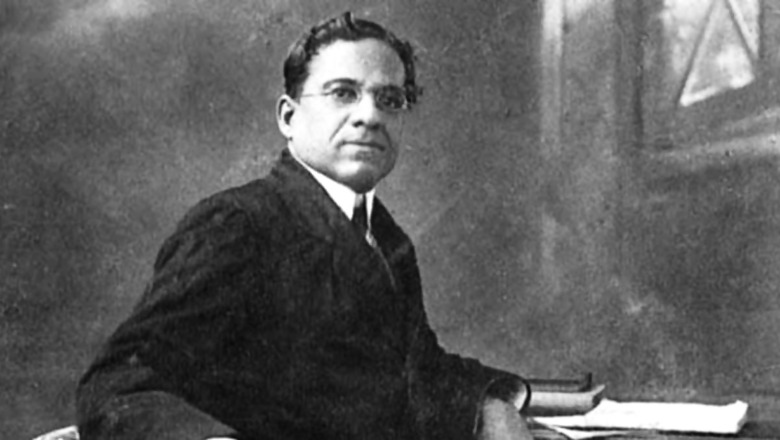
views
It started with a dream. Dhundiraj Govind Phalke, better known as Dadasaheb Phalke, wanted to tell stories with moving pictures on the screen. Frequently spoken of as the Father of Indian Cinema, Phalke made Raja Harishchandra, the first Indian feature film, in 1913. The story of his struggles before and during the making of the film is captured beautifully in Paresh Mokashi’s Marathi film Harishchandrachi Factory. Mokashi tells the story with an endearing lightness of tone, and his protagonist wins the viewer’s hearts because of his determination and innocence.
Born on April 30, 1870, into a Chitpavan Brahmin family in the Bombay Presidency, Phalke explored a variety of subjects as he grew up. He completed a course in drawing at the Sir JJ School of Art and a course in oil painting and watercolour painting at Kala Bhavan, the Faculty of Fine Arts, at the Maharaja Sayajirao University of Baroda. Restless and forever eager to pick up new subjects, it is surprising to note how much he wished to learn during his young days.
Phalke displayed an insatiable appetite for expanding his range of knowledge. He became a photographer and even performed magic as Professor Kelpha (who also appears in the Mokashi film). He entered the printing business, but eventually left it as his life continued to add new chapters with unexpected twists from time to time.
The Phalke story is interesting because of his contribution to filmmaking in India. A man with a wandering mind, he was overwhelmed after watching the film The Life of Christ, which was ‘perhaps the one made by the Frenchwoman Alice Guy’ (the French director Alice Ida Antoinette Guy-Blaché ), says cinephile and intellectual Yves Thoraval in his book The Cinemas of India (1896-2000). Thoraval observes, “As a devoted Hindu from the Brahmin caste, he thought that if Jesus could be the subject of films in the laic West, then the innumerable ‘adventures’ (and avatars) of the Hindu gods could furnish a mine of inexhaustible material.”
The novelty of cinema as a medium fascinated Phalke, who wanted to make Indian films with a distinct identity. So, he read about films, went to London, bought a camera, and eventually founded the Phalke Films Company in 1912. Phalke’s output – 95 feature-length films and 27 short films – shows his passion for the craft that played a huge role in starting a creative revolution in India.
Raja Harishchandra, based on the legend of the king of the Ikshvaku dynasty, was a film of about 3,700 feet or four reels. Theatrically released at the Coronation Cinematograph and Variety Hall in Girgaon, Mumbai, it was commercially successful. Phalke made another film in 1913, Mohini Bhasmasur, based on the mythological story of Mohini, an avatar of Lord Vishnu, who finds a way to enchant and destroy Bhasmasur, an asur with special powers. Mohini Bhasmasur is a landmark because the film has Durgabai Kamat, who plays Parvati, and her daughter Kamlabai Gokhale, who appears as Mohini, who are the first actresses of Indian cinema. Also commercially successful, Mohini Bhasmasur was followed by a third Phalke hit, Satyavan Savitri (1914), based on the Satyavan-Savitri story originally found in the Vana Parva in Mahabharat. The incipience of Indian cinema, which originated with silent films, attracted viewers and brought success to Phalke.
Another well-known Phalke film is Lanka Dahan (1917) based on Sundar Kand from the Ramayan in which Hanuman sets Lanka on fire with his burning tail. The film is well-known for the presence of restaurant employee-turned-actor Anna Salunke, who played the characters of Ram and Sita and is the first person to play a dual role in Indian cinema. Kaliya Mardan (1919) a mythological film based on Lord Krishna’s young days that ends with his battle with the demon serpent Kaliya, is an instance of how Indian cinema was when Phalke was exploring the medium.
Reflecting on Phalke’s approach to filmmaking, Thoraval makes an important observation. “It is significant that Phalke was least interested in the Westernised section of Indian society which comprised regular viewers of foreign films, and that in equal measure, the English-speaking press largely ignored him. Phalke’s objective was to create an indigenous form of the Seventh Art and to make it a profitable national industry.”
Did he succeed? He certainly did make a significant contribution in starting the Indian journey of filmmaking, which has gradually led to the technologically evolved times we live in.
Phalke’s career experienced its share of ups and downs. His company Phalke Films Company was eventually converted into Hindustan Cinema Films Company with support from prominent names, including independence activist and nationalist Lokmanya Balgangadhar Tilak and financier Sir Ratanji Jamsetji Tata. The company did produce commercially successful films such as Kaliya Mardan, but Phalke left because of irreconcilable differences and announced his retirement. He did direct more films, including those for Hindustan Cinema Films Company with whom he had a new arrangement, later. However, his career went downhill and ended with Gangavataran (1937), his only sound film made for Kolhapur Movietone at 67. Phalke died in Nashik on February 16, 1944, having faded away from the industry in which he had played such an important role for years. Having made all kinds of films, including historicals, mythological, and documentaries, his legacy has remained alive.
The Dadasaheb Phalke Award, the most prestigious prize in Indian cinema presented during the National Film Awards ceremony, is named after the restless genius who understood how moving pictures could entertain Indians more than 100 years ago. He was a true pioneer, who saw the future of entertainment through his bespectacled eyes before others did.
The writer, a journalist for three decades, writes on literature and pop culture. Views expressed in the above piece are personal and solely those of the author. They do not necessarily reflect News18’s views.




















Comments
0 comment